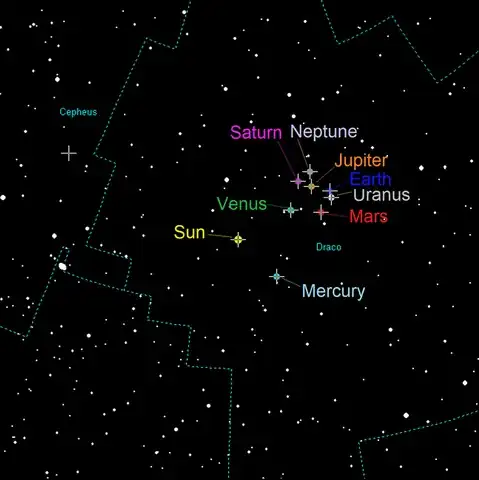If Polaris is Earth's North Star as it is directly pointed at by our North pole, what would be the North Star of the Sun?
Asked
Active
Viewed 1,287 times
13
-
2@ReactingToAngularVues: Do the Sun rotation axis and Earth rotation axis point into the same direction? I don't think so, so the Sun's "north pole" must be pointing to a different star. But anyways, it's an astronomy question and not space exploration. – DarkDust Jan 26 '18 at 08:57
-
3Well, if you trust coordinates given here https://en.wikipedia.org/wiki/Axial_tilt the Sun north pole should be in the Draco constellation, somewhere between delta and omicron draconis. – Jan 26 '18 at 09:41
-
space is north of the sun – ArtisticPhoenix Jan 26 '18 at 11:26
-
1@ArtisticPhoenix say what, now? – Carl Witthoft Jan 26 '18 at 15:19
-
@CarlWitthoft Maybe he was thinking the following: Pick any direction at random. The odds that that line intersects anything at all in the visible universe is basically zero. You have to permit a "fudge factor" to get any sensible result; polaris is itself not perfectly aligned with the earth's axis, but it's close enough to serve as a direction indicator. – zibadawa timmy Jan 27 '18 at 00:05
2 Answers
10
The North Pole of the sun points towards the constellation Draco. There is no bright star close to the North Pole of the Sun. The closest fairly bright star is Delta Draco, "Altais". A magnitude 3 star.
The other marks on the image are the "North Pole of the planets' orbits" The Earth's rotation is inclined by 23 degrees from its orbit, so the Earth's rotational North Pole is not the same as the pole of its orbit.
James K
- 120,702
- 5
- 298
- 423
-
beautiful graphic! Is it yours, or does it have a source? Consider also posting at Does Venus have a north star or south star? – uhoh Jan 31 '19 at 10:19
-
1Not mine, wikipedia, and released to the public domain by its creator. https://commons.wikimedia.org/wiki/File:Snapshot_of_the_planetary_orbital_poles.png – James K Jan 31 '19 at 22:31
3
According to the 2001 Astronomical Almanac (page C3), the mean position of the pole of the Solar equator is at right ascension 286.13 degrees (19.07 hours), declination 63.87 degrees. As James indicated, this puts it close to the star delta ($\delta$) Draconis.
JohnHoltz
- 7,982
- 2
- 21
- 30
